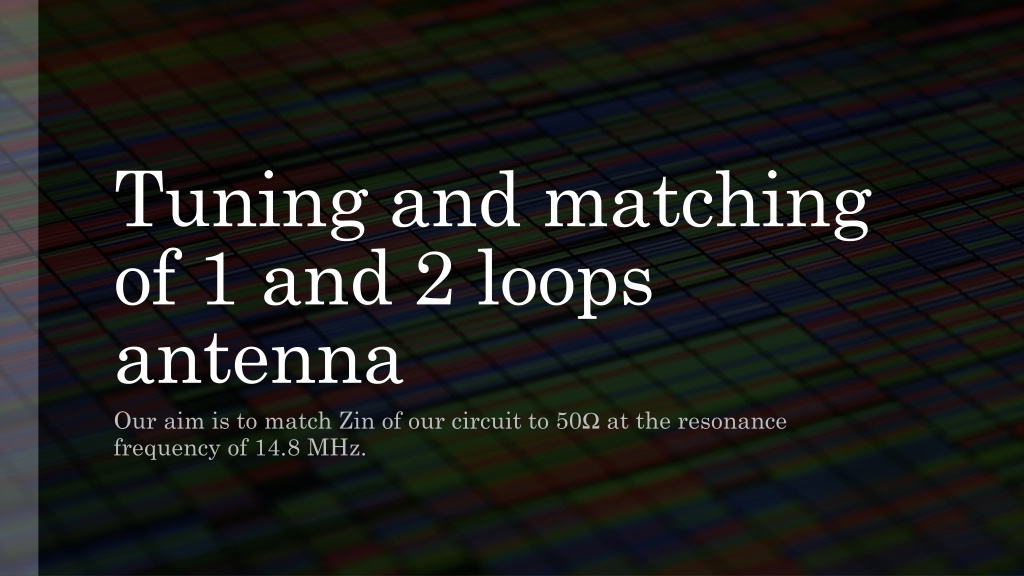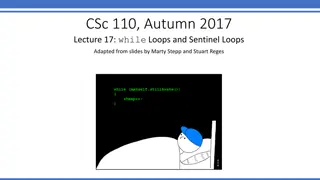Tuning and Matching of 1 and 2 Loops Antenna
The aim of the project is to match the impedance of the circuit to 50 ohms at the resonance frequency of 14.8 MHz. The process involves calculating the impedance, working at low frequencies to determine key parameters, calculating capacitors, determining Q, and finally calculating tuning and matching capacitors to achieve the desired impedance matching.
Download Presentation

Please find below an Image/Link to download the presentation.
The content on the website is provided AS IS for your information and personal use only. It may not be sold, licensed, or shared on other websites without obtaining consent from the author. Download presentation by click this link. If you encounter any issues during the download, it is possible that the publisher has removed the file from their server.
E N D
Presentation Transcript
Tuning and matching of 1 and 2 loops antenna Our aim is to match Zin of our circuit to 50 at the resonance frequency of 14.8 MHz.
Procedure 1. Calculate the impedance of our circuit, modelized as a series of R and L in parallel with C; 2. Work at low frequency to calculate L, R(0) and R(f0); 3. Calculate C from the initial formula of the impedance; 4. Calculate Q; 5. Calculate the matching and tuning capacitors Cm and Ct and include these capacitors in our circuit in order to tune and match it; 6. Vary a little the value of the capacitors in order to find the precise values which tune and match perfectly the circuit.
1 loop antenna Project_Alice_1loop_simulation
Step 1 The circuit we are referring is schematized as follows: The admittance of our circuit is the following one:
Natural frequency fn=819,5 MHz and relative impedance Z(fn)=35000
Step 2 Working at low frequency the formula for the impedance becomes: 1 Z( ) = R( ) + j L (for 0, ??? ) |Z| = | L| and so L = ? 4.85 2.43 2? 10 ??? = 38.6 nH where Z is calculated from the simulation of the imaginary part of Z in a frequency range of 10 MHz near the origin. ? = Then, we get the value of the resistance R(0) from the simulation of the real part of Z at 0 Hz: R(0) = 0.0033 We also estimate R at the resonance frequency f0=14.8 MHz: R(f0) = 0.033
Step 3 Calculate C using the forumla: C= =2,99 nF where R=R(f0)
Step 4 Determine Q measuring the resonance frequency and the bandwidth of lower and upper frequencies at 70% down from the maximum amplitude; the corresponding formula is: Q = ?0 ? = 14.45 ??? 0.131 ??? = 110.3 where f = fupper - flow = bandwidth.
Step 5 Calculation of the tuning and matching capacitors, that can be obtained using the following formulas: Cm= =8,41 nF Ct= =4,63 nF
Resonance frequency f0=14.62 MHz Matching resistance Z(f0)=46.4
Step 6 Since we want a perfect tuning and matching, we vary a little bit the value of Cm and Ct one by one and we find the precise values of the two capacitors that fully tune and match the circuit. In order to do that, we do two simulations: Tuning simulation: the value of Ct has been varied by a step width of 2 10-11 F from 4.4 nF to 4.48 nF and, simulating using 100 discrete points in a frequency range if 14.6 15.2 Mhz, it is found that the capacity that tunes our circuit at 14.8 MHz is Ct=4.46 nF:
Matching simulation: : the value of Cm has been varied by a step width of 2 10-11 F from 7.98 nF to 8.06 nF and, simulating using 100 discrete points in a frequency range if 14.6 15.2 Mhz, it is found that the capacity that matches our circuit at 50 is Cm=8.02 nF:
2 loops antenna Project_Alice_2loop_simulation
Step 1 Natural frequency fn=255 MHz and relative impedance Z(fn)=33961
Step 2 L = ? 15.1 7.53 2? 10 ??? = 0.12 H ? = R(0)=0,06 R(f0)=0.073
Step 3 C=0,96 nF Step 4 ? = 14.75 ??? Step 5 Q=?0 0.2 ??? = 73.75 Cm=3,89 nF Ct=1,27 nF
Resonance frequency f0=14,82 MHz Z(f0)=84,35
Step 6 Tuning simulation: the value of Ct gives a perfect tuning at f0=14,82 MHz Matching simulation: the value of Cm has been varied by a step width of 8 10-11 F from 4 nF to 4,32 nF (the simulation is done using 40 discrete points in a frequency range if 14 16 Mhz):
3 loops antenna Project_Alice_2loop_simulation

 undefined
undefined























